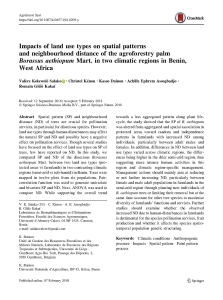Salako V.K., Kénou C., Dainou K., Assogbadjo A.E., Kakaï R.G.
Spatial pattern (SP) and neighbourhood distance (ND) of trees are crucial for pollination services, in particular for dioecious species. However, land use types through human disturbances may affect the natural SP and ND and possibly have a negative effect on pollination services. Though several studies have focused on the effect of land use types on SP of trees, few have reported on ND. In this study, we compared SP and ND of the dioecious Borassus aethiopum Mart. between two land use types (protected areas vs farmlands) in two contrasting climatic regions (semi-arid vs sub-humid) in Benin. Trees were mapped in twelve plots from six populations. Paircorrelation function was used to generate univariate and bivariate SP and ND. Next, ANOVA was used to compare ND. While supporting the overall trend towards a less aggregated pattern along plant lifecycle, the study showed that the SP of B. aethiopum was altered from aggregated and spatial association in protected areas toward random and independence patterns in farmlands with increased ND among individuals, particularly between adult males and females. In addition, differences in ND between land use types varied across climatic regions, the differences being higher in the drier semi-arid region, thus suggesting more intense human activities in this region and climatic region specific management.
Management actions should mainly aim at reducing or not further increasing ND, particularly between female and male adult populations in farmlands in the semi-arid region through planting new individuals of B. aethiopum trees or limiting their removal but at the same time account for other tree species to maximise diversity of farmlands’ functions and services. Further studies should examine whether the observed increased ND due to human-disturbances in farmlands is detrimental for the species pollination services, fruit production and whether it affects the species spatiotemporal population genetic structuring.
Consultez la notice complète de l’article sur ORBi

